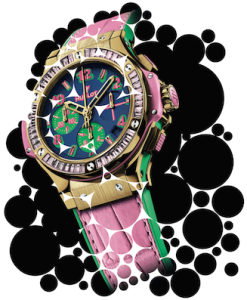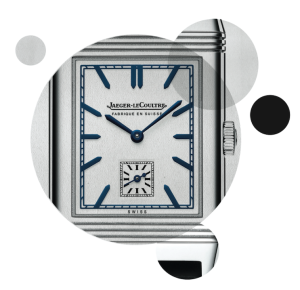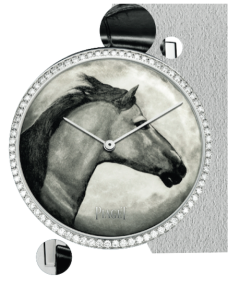connect with the hour glass
New Watch! • 09 Oct 2015
Ladies First
AT BASELWORLD THIS YEAR, the unexpected happened. And it was the work of a brand not known for its surprises. In the midst of this annual event, during which watchmakers reveal their latest creations, Rolex snubbed tradition. It announced a mechanical first — but not one housed within a men’s watch. Instead, the new part debuted in a watch for women.
The Oyster Perpetual Datejust Pearlmaster 34 was the timepiece. In-house-made calibre 2236 was the movement. And an advanced type of silicon hairspring, the Syloxi, was the technological coup. Though diminutive in size, Rolex’s Syloxi silicon hairspring is hardly small in significance. Reportedly 10 years in the making, the spring is believed to boost power reserve and to more accurately measure time. This is due to the improved stability that silicon provides compared with its predecessor, a metal alloy.
“I would never expect a precious stone-laden timepiece for women would be how Rolex debuts a new technology,” wrote commentator Ariel Adams when the news broke. “Women are not traditionally the key demographic to be interested in the details and performance of a watch movement.” But perhaps our collective memories fail us. After all, it was women who first embraced the wristwatch. Instead of Rolex leading a change in tradition, could the move instead reflect a return to tradition? A quick historical review reveals that less than 110 years ago, most men wouldn’t be seen dead wearing a watch.

“In those days of yore, real men carried pocket watches,” writes International Watch Magazine’s horological expert John E Brozek. Wristlets, as they were called, were reserved for the fairer sex and deemed a passing fad. Many a gentleman reported that he would “sooner wear a skirt than a wristwatch”, Brozek says. Earlier still, Queen Elizabeth I and Marie Antoinette embraced the watch — albeit in varying incarnations. It took gents until the early 1900s to see the light. Watch faces affixed to crude leather straps proved useful during war, they found. Soon, the trend caught fire and it has blazed ever since. Fast-forward to 2014 and men claim the lion’s share of a market estimated to sit at US$50 billion. But, as the Rolex Syloxi spring rebellion indicates, the tables may be turning. Sales of watches to women now comprise roughly 35 per cent of the segment overall, with most of the major brands reporting similar figures to this. For example, the Bloomsberg Business Network reports that for Audemars Piguet’s portfolio of watches the total sits at 25 per cent.
A similar tune plays in more independent pockets of the market. Stand-alone brand Parmigiani Fleurier’s customers are 30 per cent women, and for Maximilian Büsser and Friends, women account for 20 per cent of all sales. That said, those watches leaving showrooms — and finding homes on women’s wrists — today are quite dissimilar to their counterparts from a decade ago. In the noughties, “a woman’s watch was a small quartz-movement timepiece, set with shining stones. Then the industry discovered that women were also attracted to complex mechanics,” says Urwerk co-founder and master watchmaker Felix Baumgartner.
This doesn’t mean that jewellery pieces for women are on the slide — quite the opposite, in fact. This upward trend has forged a number of fruitful collaborations between jewellers and artisanship-focused brands: Maximilian Büsser and Friends teamed with haute joaillerie-makers Boucheron to make the ‘owl’ piece JwlryMachine, while Parmigiani Fleurier produced the Tonda Pomellato in concert with jeweller Pomellato.
“Our ladies’ watches are never a mere extension of the man’s watch,” says Parmigiani’s vice-president of marketing and communications Catia Hofmann. “There is a true effort of research and original creation in every woman’s timepiece.”
Piaget and Vacheron Constantin provide fuel for her argument. Both marques unveiled exclusive women’s lines earlier in the year. Even more interesting than the renewed enthusiasm for bling, however, is that while of creativity. Even more interesting than the renewed enthusiasm for bling, however, is that while the pool of women’s watches widens, so too do reserves of creativity.This has led to greater experimentation via artistry, materials and colour.
At the forefront of this trend is Hublot. At the same time as Rolex announced its Syloxi spring, Hublot released the Big Bang Pop Art — a design that marries bright bursts of colour with a self-winding mechanical chronograph. Earlier, the brand launched the denim/precious metal-fusion Big Bang Jeans, as well as the mechanically mega Big Bang Tutti Frutti Tourbillons. As CEO Ricardo Guadalupe says of the latter, “It was the first time people could see tourbillons that [were] fashionable, colourful and happy. These were only for women!”
Watchmaking maverick and founder of MB&F Maximilian Büsser treads a slightly different path on the subject of women’s watches. He sees it as disrespectful to first envisage a buyer, then cater to her will. “Is art gender biased? I hope not,” he says. “We create pieces of art, meaning we create something we are proud of, something which talks about us creators — and as much about our feminine sides as it does about our masculine sides.” Usually, women go for the brand’s most extreme pieces, Büsser says.
“And that’s what I find amazing.”
Here are some fine timepieces that are for the Ladies:
LONGINES COLUMN-WHEEL SINGLE PUSH-PIECE CHRONOGRAPH

Longines is big on vintage this year. Part of the Heritage Collection, the unisex Longines Column-Wheel Single Push-Piece Chronograph is a re-creation of the brand’s first line of chronographs. We particularly like the L2.775.8.23.3, with its 40mm case.

Described as ultra-feminine, Hublot’s new Big Bang Pop Art series combines the HUB 4300 mechanical chronograph movement with an Andy Warhol-inspired palette. The brazen design has a choice of canvases in pink, blue, purple and apple green.
JAEGER-LECOULTRE GRANDE REVERSO ULTRA THIN 1948

JLC’s cult creation, the polo-inspired Grande Reverso, adds the 1948 to its suite of new Ultra-Thin Reversos — a collection that has been revived steadily since the Reverso’s 80th birthday in 2011. This model is steeped in Swiss watchmaking references, from the blue-on-white dial down to the words etched on its face.
PIAGET ALTIPLANO 38MM BULINO ENGRAVING

Piaget has relentlessly pursued the ultra-thin watch, resulting in the 38mm Altiplano. Thirty-two watches form an offshoot collection, A Mythical Journey by Piaget. This draws inspiration from the silk and spice routes and is engraved using the bulino technique via strokes with an angled tool.

Boucheron, the French jeweller with which MB&F paired for the JwlryMachine, is known for its whimsical creations. After 40 attempts, together the brands chose the owl for this version of the HM3. While it may wear pink-toned quartz or purple amethyst on the outside, the timepiece has a mechanical heart, made from 305 components.
As seen in the ![]() magazine
magazine
This article was originally published in The Hour Glass Australia Magazine Issue 7.



